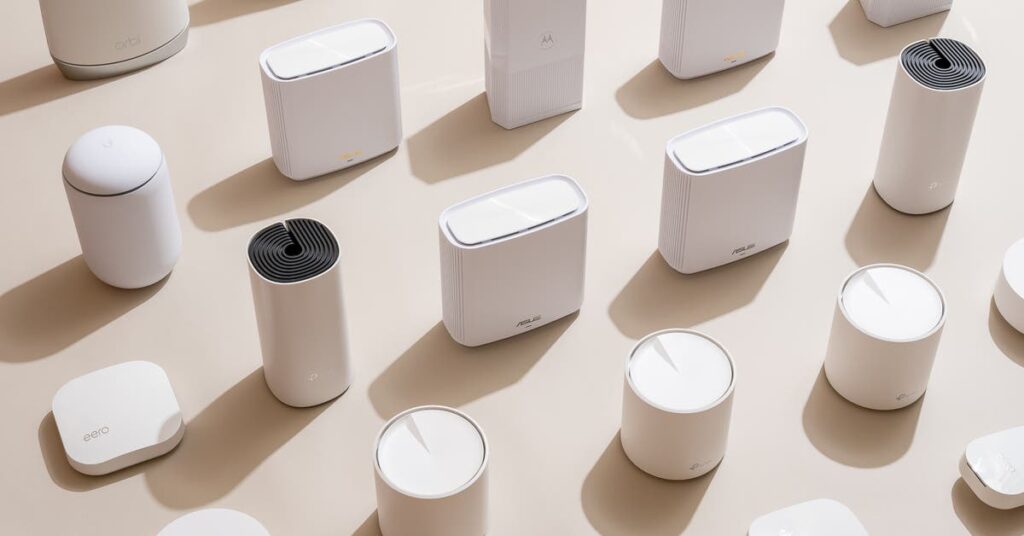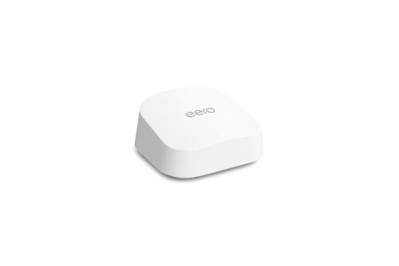Top pick
The Eero 7 is quick to set up, inexpensive compared with rival Wi-Fi 7 mesh systems, and capable of spreading a lag-free Wi-Fi network throughout your home. We tested the Eero mesh system all over a three-story house, where it outperformed systems costing two or three times as much.
It’s speedy enough for gigabit service. During our testing, the Eero 7 offered fast performance, measuring at a quick 806 megabits per second (Mbps) when our test laptop was close to the base router. Speeds slowed a bit when our laptops connected through the Eero 7’s second router, but overall it kept speeds between 56 Mbps and 560 Mbps, which is more than enough for multiple 4K-video streams and simultaneous game downloads. Some more expensive Wi-Fi 7 mesh networks, like our upgrade pick, the TP-Link Deco BE63, ultimately tested faster overall. The median speed for fixed broadband, which includes both cable and fiber internet service providers, was about 280 Mbps in February 2025, so a range of 56 Mbps to 800 Mbps is quite acceptable for many homes in the US.
Setup is simple. The Eero 7 should take from five to 20 minutes to set up, much faster than some of the more finicky mesh networks we’ve tested, which can take over an hour. After plugging in the Ethernet cable from your cable modem or fiber gateway, and the included USB-C power adapter, there are the usual prompts for setting your network name (SSID, for service set identifier) and network password. Then the app gives you some tips for placing the second Eero router. After placing both Eero units (and performing an automatic firmware update), you should have a functioning mesh network in your home.
The Eero app is easy to use. It lets you switch between WPA3 security and the WPA2 security built into older routers, but that’s one of the few settings you can change beyond network name and password—which makes it simple for a novice or remote family member to monitor the network. All Eero and Eero Pro systems have a temporary off switch for their 5 GHz network, which makes it easier to connect smart devices like cameras and doorbells.
Compatibility and support are solid. All currently available Eero systems are compatible with each other. For example, you can add an Eero Pro 7 or Eero 7 system to an existing Eero 6 network, if you need to cover more space throughout your house. The Eero 7 (and other Eero systems) supports HomeKit, Matter, Thread, and Zigbee, four smart-home standards for controlling your devices. Because Eero’s parent company is Amazon, recent Echo devices and the Alexa voice assistant are also supported.
It can handle a lot of traffic. In our responsiveness tests, the Eero 7 was competitive with the best mesh systems. Even when the Wi-Fi network was at its most congested, the Eero 7 was able to stream 4K videos, download large files, and keep multiple web browsing sessions lag-free. Other more expensive systems, such as Asus’s ZenWifi BQ16 Pro, slowed down when the network was busy.
Flaws but not dealbreakers
The simple design sacrifices ports. It has only one extra 2.5-gig Ethernet port on the base unit and two on the second router. In contrast, our upgrade pick, the TP-Link Deco BE63, has four 2.5-gig ports on each router.
The optional subscription is pricey. Eero charges between $100 and $120 per year for its Eero Plus subscription, which is necessary to access parental controls and anti-malware protection—services that Asus’s ZenWiFi systems include for free. The Eero Plus subscription is entirely optional, however: The Wi-Fi network will continue to work without the parental controls and anti-malware.
It’s dual-band Wi-Fi 7. To save on costs and reduce complexity, the Eero 7 eschews the 6 GHz radio that more expensive Wi-Fi 7 and 6E mesh routers have. Eero also omitted that feature to make the Eero 7 available in countries and territories that heavily regulate the 6 GHz radio bands. 6 GHz bands may be faster, but they also have a shorter range than 2.4 GHz and 5 GHz bands. This ultimately makes the Eero 7 less attractive if you already have Wi-Fi 7–equipped laptops and if you have an internet connection faster than 2.5 Gig. If you’re part of that early-adopter group, our upgrade pick might be a better choice.
You have to administer the mesh network in the cloud. Technically, bad actors could monitor your data via this login, though Amazon and Eero assure us that they safeguard your data and online activities. Mesh networks from Asus, Linksys, and Netgear also use apps for login and setup, but the latter three (and a few others) give you an option to administer each router locally via a web page.
You have to use the Eero app to control the network. It’s not flexible. There are very few settings you can actually change in the app, which makes Eero not as flexible as its rivals. Many standalone routers and some of the other mesh systems listed here will let you set parameters like 5 GHz and 2.4 GHz channels, wireless signal strengths, and the ability to create separate network names (SSIDs) for keeping smart-home devices separate from your laptop network.
While it is now owned by Amazon, the Eero company developed and released its first two generations of mesh networks independently of Amazon. We think that the ease of setup, frequent firmware updates (as needed), ability to add Eero units to expand coverage, ability to manage a network remotely, and company’s proven track record outweigh these concerns.
How Eero has held up
In general, we’ve had good-to-excellent experiences with the Eero 7 and other Eero models. As my family’s technology manager, I’ve kept my parents’ Eero home network glitch-free, while remotely managing it and monitoring automatic firmware updates from my phone. Senior staff writer Tim Heffernan installed an Eero 6+ to provide a “strong, solid” connection to a back room that our former Wi-Fi extender upgrade pick, the Asus RP-AX56, couldn’t reach in their apartment. Senior editor Christine Ryan’s partner, who owns and manages an Airbnb rental, “loves his Eero mesh network, because it provides good Wi-Fi throughout the unit (which is two floors plus a loft), and he gets a notification any time someone logs in, so he knows when guests have arrived.”


